Have you got a video? You've got our attention.
Today, video content is skyrocketing and dominating the internet. Videos are a massive part of our internet life, and they're huge for everyone scrolling on their phones. Check it out.
- 82% of it is people watching videos.
- 89% of people on the internet watch online videos every day.
- 60% of all that video watching happens on our phones.
Consequently, there is a massive opportunity for content publishers and advertisers to fill their insatiable demand for more video content.
Let's talk about eight trends demonstrating this massive trend in video consumption and growing demand for video content in more detail and what this means for publishers.
1. Get the Attention of Gen Z - A Video-First Generation
The younger crowd, especially Gen Z, is all about videos. They're the ones who are growing up with phones in their hands and growing with buying power. Here's a quick look at just how much video means to them:
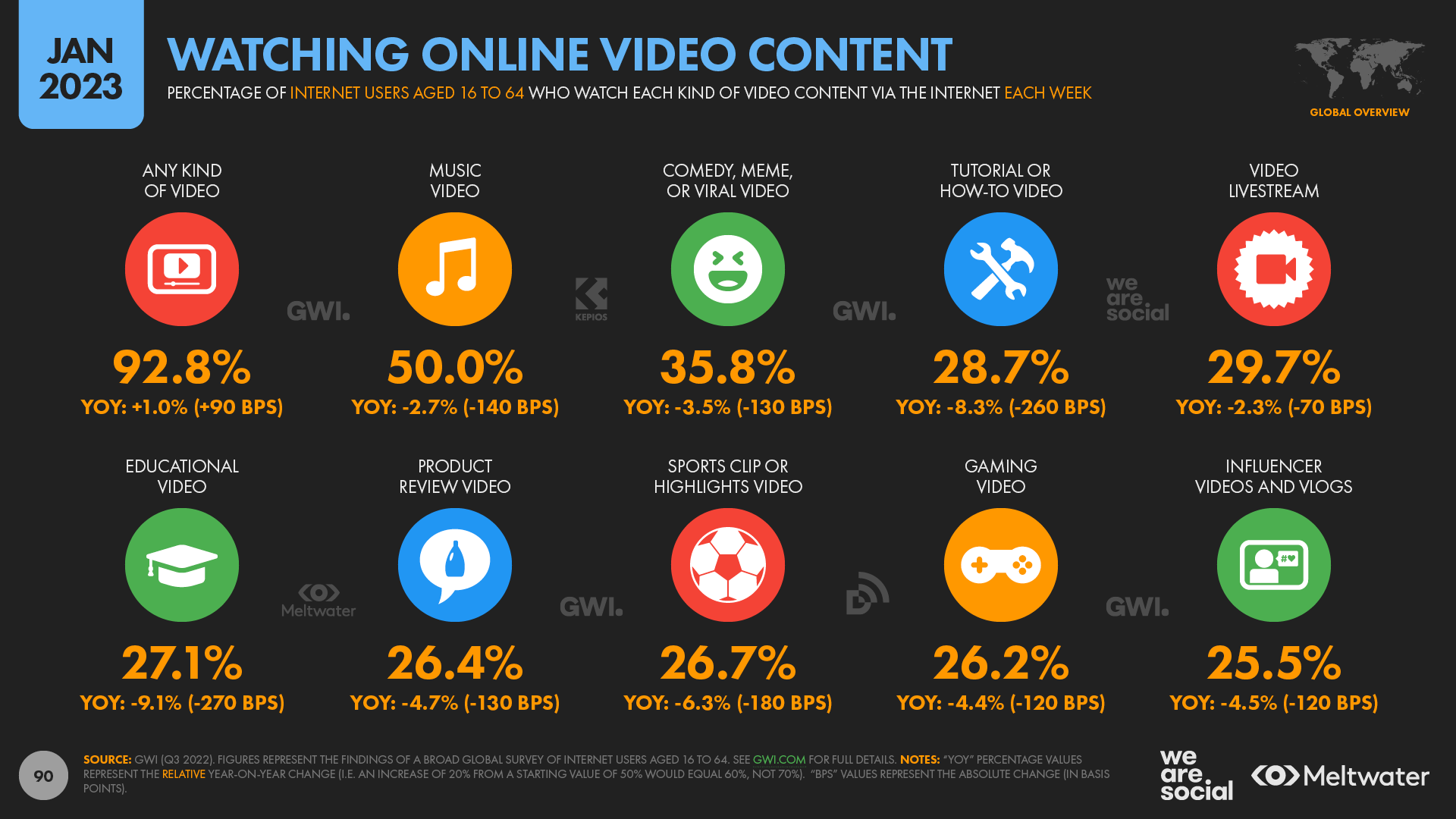
- Nearly every Gen Z'er watches digital videos – that's 97.8%.
- They're watching more than just a quick clip here and there. Gen Z devours over three hours of mobile video daily.
- When shopping, they're 150% more likely to buy something if they've seen it in a video.
- You've got to grab their attention fast; they typically focus on a video for about 1.3 seconds before deciding to keep watching or scroll past.
- 65% of Gen Z wants content that feels made just for them.
What This Means for Publishers:
- If you want to talk to Gen Z, you've got to do it through video - and make it snappy.
- Keep it short, whether it's a social media post, an ad, or a product demo. We're talking 5 to 60 seconds tops.
- They also love to shop through videos, so this is your chance to show off your products in motion. Think of quick, eye-catching, shoppable clips.
- Use what you know about your viewers to make content that feels personal. More on this later.
Brands need to be smart about how they use video for this crowd. They're not only looking for something cool to watch; they want personalized videos and the option to buy what they see without breaking a sweat.
For more insights on tapping into the video-first nature of Gen Z, check out HubSpot's definitive guides on the topic. You can engage this up-and-coming generation with thoughtful, targeted video content and turn them into loyal fans and customers.
2. Video Drives Purchasing Decisions
Guess what? Watching an excellent video about a product can make you want to buy it—big time. Here's the lowdown:
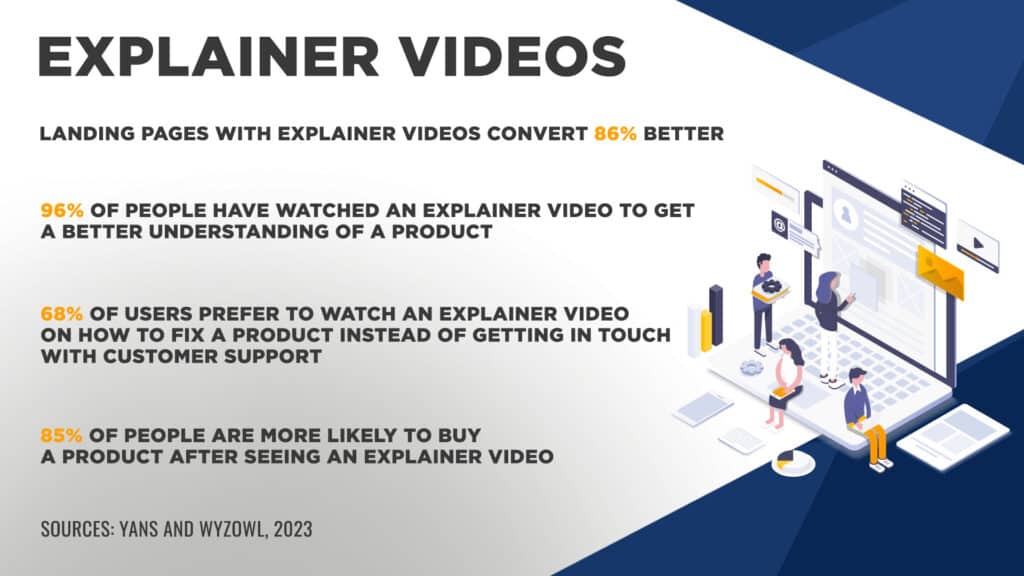
- 82% of consumers may be convinced to buy something after watching a video about it.
- If that's not enough, 84% felt fired up to make a purchase just from a video.
- Explainer videos are essential – 90% of consumers find them super helpful.
We're seeing here that videos aren't just fun to watch—they're a powerful tool that can get people to open their wallets. Whether it's on a product page on Amazon or a snappy YouTube ad, brilliant videos can turn viewers into buyers.
What This Means for Publishers
- Videos are now a must-have on your website. They can show your product in action and convince someone they need it.
- It's more than just the long videos that work. Short video ads, like those 6-second YouTube bumper ads, can leave a big impression, too.
If you're selling something, think about how you can show it off with a video. From quick teasers to full-on demos, video marketing can be a game-changer for your conversion rates.
Dive deeper into how videos can turbocharge sales by exploring case studies and reports on Wyzowl, where businesses share their successes with video marketing strategies.
Related Article: Aeon's Guide to Online Video Players
3.Video Lifting Sales and Leads
Let's dig into some complex numbers that show just how much video is changing the sales game:
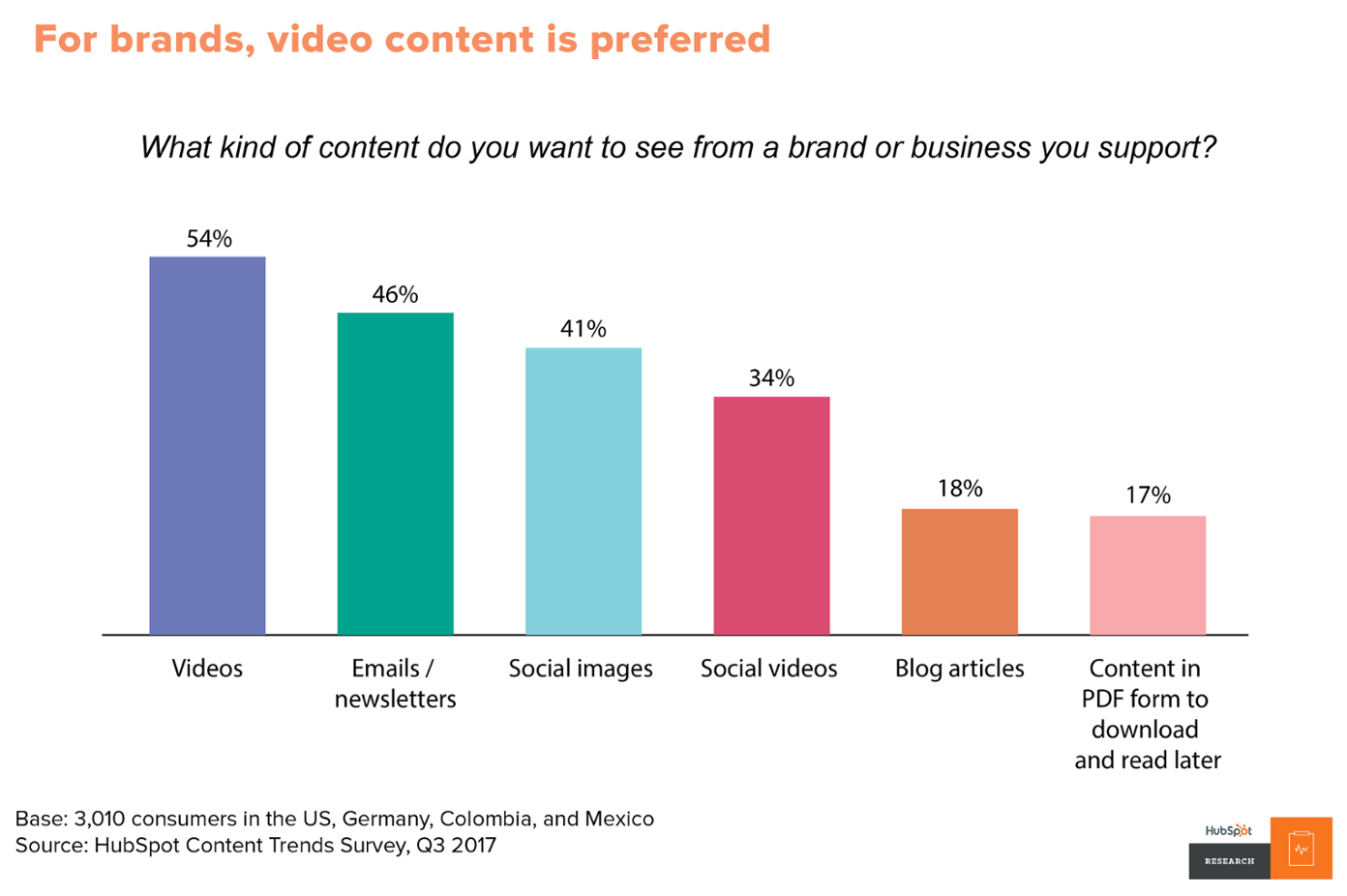
- Companies using video enjoy 41% more web traffic from search than non-users.
- Using the word 'video' in an email subject line boosts open rates by 19% and click-through rates by 65% (Forbes).
- Real estate listings that include a video receive 403% more inquiries than those without.
These stats paint a pretty clear picture: video is a heavy sales and lead gen hitter.
What This Means for Publishers
- Including accompanying video on your site is mission critical. It can showcase your product in the best light and get that "add to cart" click.
- Email marketing gets a supercharge when you drop a video in there. It turns mundane updates into must-see messages.
- For the higher-stake sale, like property, video offers a rich, immersive experience that a gallery of images or text description can't match.
Real-life Examples
- Demo videos from tech companies like Zendesk show their software in action, leading to a better understanding and increased interest.
- Real estate agencies use virtual walkthroughs to help potential buyers feel right at home before setting a foot in the door, leading to faster sales.
- Fashion retail giants like Zara leverage video commerce strategies to drive impulse purchasing.
No matter what you're selling, there's a video type that can help boost those numbers. From tutorials that teach to testimonials that build trust, it's all about connecting with your audience and giving them a visual handshake.
4. Social Media Depends on Video
Social media platforms are parties where the video is the guest of honor. Everybody's watching, posting, and sharing videos—billions of them daily.
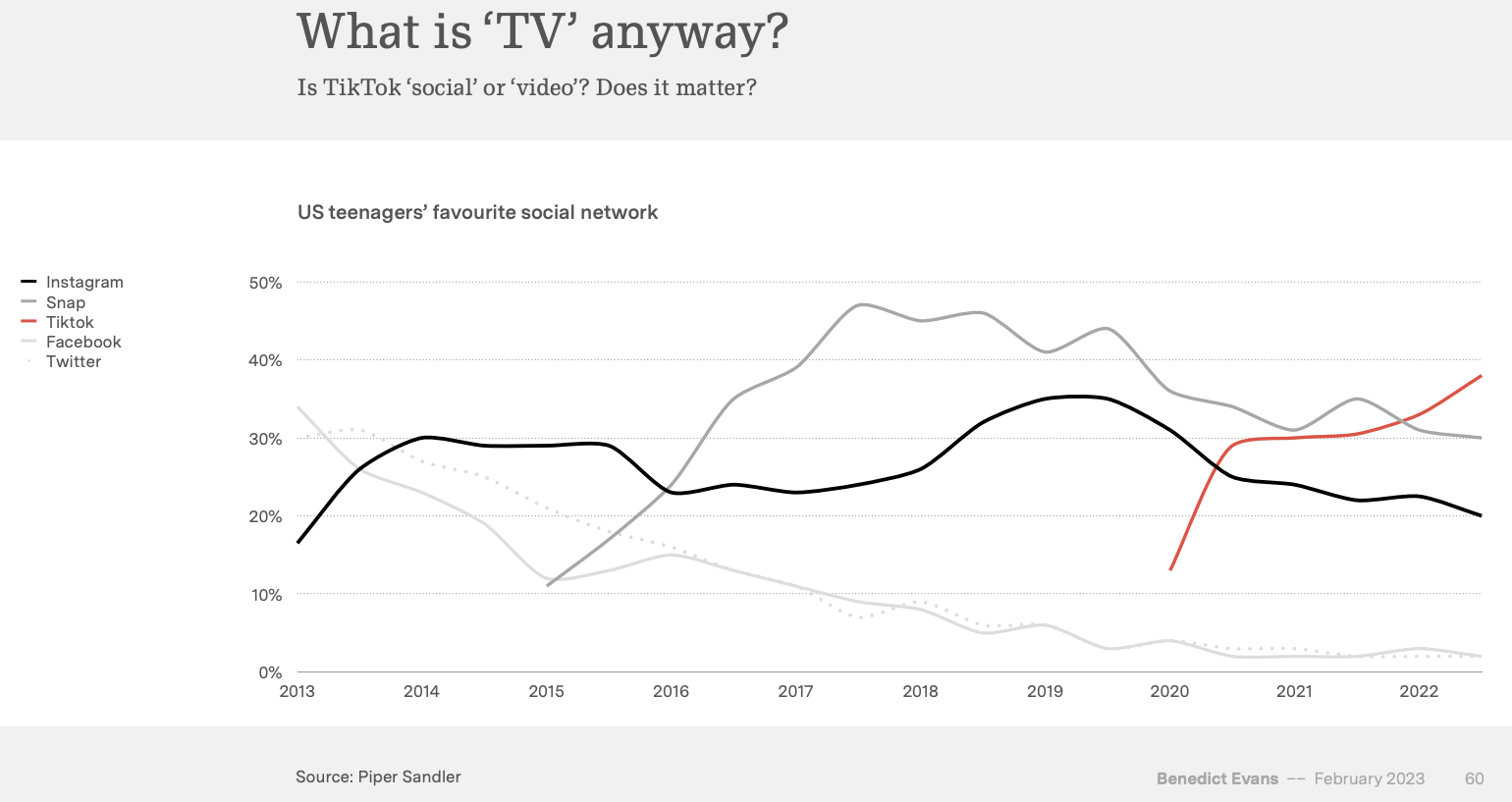
- Facebook reports over 8 billion video views per day, which could include anything from a friend's vacation clips to brand promotion.
- Instagram stories have 500 million daily active users; one-third of the most viewed stories are from businesses.
- On TikTok, users spend an average of 52 minutes daily on the app, creating and consuming quick-form video content.
What This Means for Publishers
- With billions of potential views daily, having a robust video presence on Facebook can significantly enhance brand awareness.
- Instagram's massive daily use of stories points to the need for brands to create visual, engaging, and short-lived video content to keep users hooked.
- The average time spent on TikTok daily represents a significant opportunity for brands to reach their target audience through creative and trend-savvy video content.
Real-life Examples
- Blendtec's viral video campaign "Will it Blend?" showcased its blenders' power and brand personality, generating sales and extensive social media buzz.
- BuzzFeed's Tasty leverages quick, visually captivating cooking videos on Facebook and Instagram, garnering billions of views and shares driving engagement.
- Gymshark uses influencer marketing on TikTok to create relatable workout and fitness content, catapulting its brand into a leading position within the fitness apparel industry.
Brands leveraging video on social platforms are witnessing a notable rise in user engagement, brand visibility, and sometimes virality. When done correctly, these videos can transform casual browsers into dedicated followers and customers.
By examining platforms like Social Media Examiner, businesses can learn the strategies behind successful video marketing campaigns across various social media platforms.
5. Video Production Moving to AI
Now, let's talk about the tech magic of AI. It's not just robots and sci-fi – AI is also shaking up how videos are made.
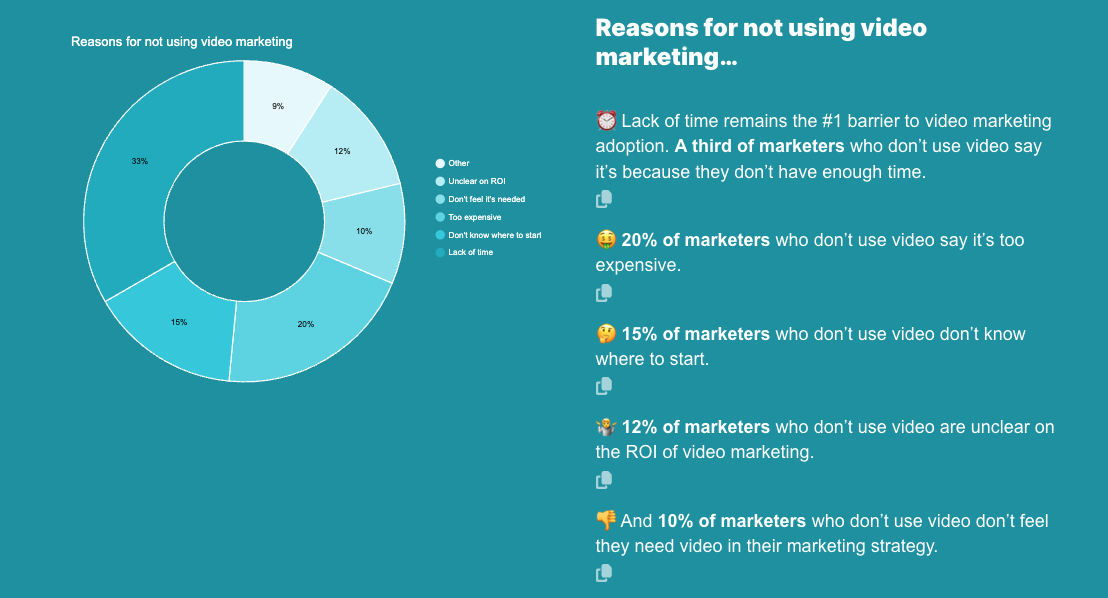
- Lack of time remains the #1 barrier to video marketing adoption. A third of marketers who don’t use video say it’s because they don’t have enough time.
- Adobe's State of AI report suggests that 47% of digitally mature organizations, those with advanced digital practices, indicate they have a defined AI strategy for video production (Adobe).
- AI startup Deepfake reports that over 15,000 videos have been produced using their technology, indicating a growing trend in AI-assisted video creation.
What This Means
The use of AI in video production isn't just a fad—it's becoming a standard part of the process due to its efficiency and sophistication.
Real-life Examples
- The Weather Channel has deployed AI-powered mixed-reality videos to simulate weather events during live broadcasts, enhancing viewer understanding and engagement.
- Aeon uses AI to turn text into beautiful videos, cutting down the hours-long editing process to just minutes by automatically piecing together the best shots and dialogue.
- News agencies like Xinhua have introduced AI anchors that deliver news in multiple languages, drastically reducing production costs and enabling real-time news updates.
These examples underscore how AI is accelerating and democratizing video production, allowing smaller teams and even individuals to produce high-quality video content that was once the sole domain of large corporations with deep pockets.
Harnessing AI isn't about replacing humans; it's about augmenting our capabilities and letting us focus on the creative decisions that require a human touch while AI handles the time-intensive, manual tasks.
6. Personalized Video Gets Results
Tailoring Video Content for the Individual Viewer
In a world overflowing with generic content, personalized video is like receiving a custom-made gift; it just feels special.
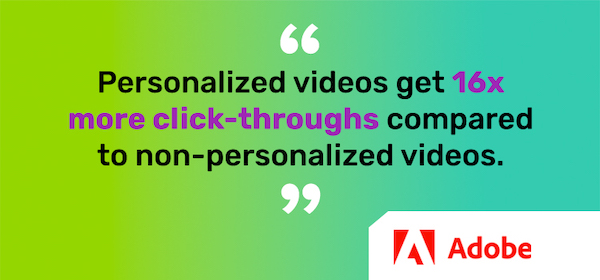
Let's look at the numbers:
- Personalized video campaigns drive a 35% higher retention rate among viewers.
- When videos are tailored to the viewer's locale, engagement rates soar.
- According to a survey by Vidyard, 87% of businesses report that personalized video content has increased their website traffic, and 83% confirm that it helps them generate leads .
- The Demand Gen Report shows that leads who receive personalized content, such as videos, exhibit a 20% increase in sales opportunities.
Personalized content is the golden ticket for keeping your audience glued to the screen.
What This Means for Publishers
- Expect more videos in your inbox that reflect your name and your interests.
- Localized content – think videos in your language and featuring your city – isn't just lovely; it's becoming expected.
Real-life Examples
- Marketo, a leader in marketing automation, utilizes personalized video in its email campaigns to address recipients by name and industry, directly linking to increased engagement and conversion rates (Marketo).
- Cadbury created a personalized video campaign that matched users with Dairy Milk flavors based on data from their Facebook profile, leading to a 65% click-through rate and a 33.6% conversion rate, significantly higher than the industry benchmark.
- Businesses like Spotify are already on board, adapting playlists and adverts to your musical tastes and listening habits. When you see your name in a video, or it mentions something totally "you," the connection is accurate, and so is the impact.
Marketers know that when they show you a video that mirrors who you are and what you love, you're more likely to engage with the brand, share the content, and remember the message.
Although the following clip is more about music, the key point applies. Check out Post Malone on Joe Rogan describing personalized AI music as a fun Easter egg.
Personalization in video marketing isn't a future trend – it's here and making a splash. Platforms like Vidyard offer tools to create customized videos at scale, proving how this technology can be part of a successful marketing strategy today.
With personalization at the forefront, businesses can cut through the noise to deliver individualized experiences that resonate, win hearts, and build brand loyalty.
7. Employees Want Video Learning
The days of dense manuals and droning lectures are fading fast. Now, it's all about hitting play and learning in a way that's engaging and easy to digest.
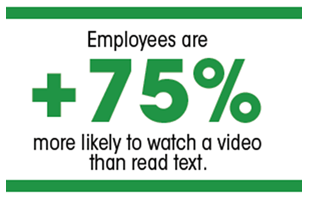
- Research by the Aberdeen Group indicates that organizations using video for training see a 218% higher revenue per employee than those without video-based learning .
- Forrester found that employees are 75% more likely to watch a video than to read documents, emails, or articles.
What This Means for Publishers
The key takeaway is that video learning platforms are on the rise, providing a scalable way to equip employees with the necessary skills and knowledge to thrive in today's fast-paced business environment.
Real-life Examples
- Tech giant Microsoft uses video to aid employee onboarding and continuous learning, reporting that this method has significantly improved knowledge retention and company-wide productivity.
- SAP, a market leader in enterprise application software, has revolutionized its training with a comprehensive library of video tutorials, enabling its global workforce to learn and adapt to new software solutions comfortably.
From multinational corporations to startups, video learning solutions like those provided by Microsoft and SAP express a growing preference for visual, self-paced learning environments. They exemplify the shift towards more dynamic, interactive, and engaging formats of professional education.
The ability to pause, rewind, and review complex information is a game-changer in technical fields and beyond. This ease of access and control over learning pace and style makes video an increasingly sought-after medium for training that sticks.
The key takeaway is that video learning platforms are on the rise, providing a scalable way to equip employees with the necessary skills and knowledge to thrive in today's fast-paced business environment.
8. Video Length and Quality Matter
Regarding video, It's a delicate balance between saying what you need to say and not wearing out your welcome. It turns out size—or length—does matter. And so does quality.
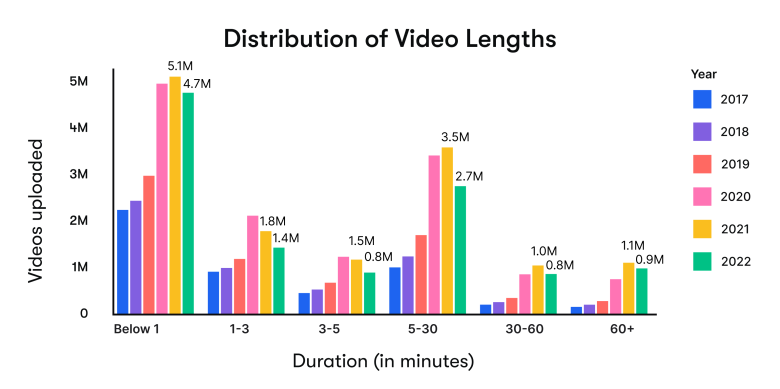
- Statista reports that 41% of internet users aged 16 to 24 prefer platforms offering short, engaging content, suggesting a strong inclination towards platforms like TikTok (Statista).
- Vertical video isn't just for social media. Even tech giants like Samsung produce vertical TVs, emphasizing that this format isn't a fad—it's the future (Samsung Newsroom).
- Wistia's video length study concludes that while 2-minute videos are tops for engagement, there's also a significant retention rate for 6-12-minute videos, suggesting different lengths work for different purposes (Wistia).
- According to a report by Social Media Week, videos up to 2 minutes long get the most engagement. Still, there is only a slight drop-off between 2 and 3 minutes, challenging creators to consider the value of their content over strict length guidelines (Social Media Week).
What This Means for Publishers
- Aim for punchy, concise messages in your videos for those just starting with video—like the quick hits popular on YouTube Shorts.
- But keep in mind that quality matters. Low-quality video won't do your brand any favors, no matter how short and snappy it is.
- Companies like Dollar Shave Club exploded onto the scene with a quality short video that went viral thanks to its humor and clean production.
- Meanwhile, Adobe Spark makes it easy to create high-quality, short videos that connect with an audience without needing a professional videographer.
Real-Life Examples
- Nike set the pace with the "Play New" campaign on TikTok, featuring short videos that motivate users to embrace sports in new ways, effectively engaging with Gen Z (Nike News).
- Netflix embraced vertical video previews in its mobile app, recognizing that users browse vertically, and these tailored teasers make choosing what to watch easier and more enjoyable (Netflix).
- Twitter has leveraged its video platform to offer brands a chance to reach out with concise videos that fit perfectly into the fast-paced scrolling of their users' timelines, often finding success with videos just under a minute.
- TED Talks, often between 10-18 minutes, defy the short-video trend with high retention rates, proving that if the content is engaging and valuable, viewers will stay tuned in, showcasing content success beyond the 2-minute mark (TED)
Short, snappy, and vertically oriented videos align with the habits of younger audiences, carving out a significant presence in everyday media interaction.
Once a novelty, the vertical format has been adopted by Snapchat through its "Shows" feature, leading to increased time spent on the app and highly positive audience feedback. It demonstrates that when companies tailor their content to the behaviors and preferences of their audience—in this case, the screen orientation of smartphone users—it pays off in engagement and retention.
By incorporating these insights into their video production strategy, media companies and marketers can better attune their content to resonate with a generation that has grown up swiping and tapping on mobile screens.
Conclusion: Embracing the Power of Video in Your Marketing Efforts
As we've navigated the terrain of video marketing, it's clear that video is much more than a trend—it's a fundamental shift in how we communicate and persuade in the digital age. The dynamism of video meets a diverse range of needs, be it educational, entertainment, or e-commerce.
Here's a quick recap of what we've learned:
- Video Consumption is Skyrocketing: People are immersed in video; it's what they prefer, and mobile devices are their screens of choice.
- Gen Z Leads the Video-First Wave: This generation lives and breathes video; tailoring content to their habits and preferences is crucial.
- Video Influences Buying Decisions: Engaging product videos translate directly into sales, underscoring the role of video in the modern customer journey.
- Short-Form Video Reigns Supreme: In the fast-paced online environment, brevity paired with quality garners the most engagement.
- Video Boosts Sales and Leads: Regarding marketing tools, video drives interest and action.
- Social Media is Synonymous with Video: Video content is the lifeblood of social platforms; it's vital for engagement and brand awareness.
- AI is Reshaping Video Production: AI tools are revolutionizing how videos are made, making it faster and more cost-effective than ever.
- Personalization Wins in Video Content: Customized video experiences resonate more deeply, leading to better retention and conversion.
- Video Learning is the New Classroom: Employees embrace video for professional development, favoring its convenience and effectiveness.
- Quality and Length Matter in Video: Content creators should balance delivering value and maintaining brevity without compromising quality.
Moving Forward with Video
As you craft your marketing strategy, remember that video is a potent tool for building trust, engaging a diverse audience, and ultimately guiding them through the customers' journey—the statistics, trends, and real-world examples all agree. But it's not just about jumping on the bandwagon; it's about strategic execution.
- Start by understanding your target audience and their preferences.
- Incorporate video types that align with your goals, from explainers to testimonials.
- Embrace new technologies and platforms, like TikTok for short videos or LinkedIn for professional content.
- Use metrics to guide your video marketing efforts and continually optimize based on performance.
- Always prioritize the creation of high-quality, relevant content that adds genuine value.
Whether you're reaching out to potential new customers or nurturing current ones, video has the power to captivate and connect like no other type of content. It's time to harness this power and tell your brand's story in a way that's visually compelling, emotionally engaging, and impossible to ignore.
Ultimately, video is more than a marketing tool—it's a language. Learn to speak it fluently; the digital world is yours to command.
